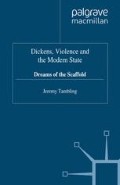Abstract
In this chapter, I look at a resistance in Dickens to the surveillance and control of modernity, a resistance through allegory. Allegory in Dickens seems an obvious subject: his reliance on the ‘humours’ mode of writing associated with Jonson and Bunyan makes it already tendentially allegorical. But that mode of writing is associated with unitary meanings, with stability and closure and the assigning of fixed subject-positions. Allegory as an other (allos) way of speaking, a secret language in which public meanings are inverted, rather suggests the doubleness of a text, which is public speech, or private, secretive if it is deliberately read for allegoresis. And if speech is in any case already ‘other’, as Lacan for example suggests, not immediate or transparent, that decision is preempted; everything becomes allegory.
There were things to gaze at from the top of Todgers’s, well worth your seeing too. For first and foremost, if the day were bright, you observed upon the housetops, stretching far away, a long dark path: the shadow of the Monument: and turning around, the tall original was close beside you, with every hair erect upon his golden head, as if the doings of the city frightened him.
Martin Chuzzlewit, 9.131
Access this chapter
Tax calculation will be finalised at checkout
Purchases are for personal use only
Preview
Unable to display preview. Download preview PDF.
Chapter 3 ‘A Paralysed Dumb Witness’: Allegory in Bleak House
Baudelaire, ‘Le Cygne’, Les Fleurs du Mal (London: Picador, 1987), p. 269
Walter Benjamin, Charles Baudelaire: A Lyric Poet in the Era of High Capitalism (London: Verso, 1983), pp. 49–50, 69–70.
John Osborne as The Origin of German Tragic Draina (London: Verso, 1977).
Ned Lukacher, Primal Scenes: Literature, Philosophy, Psychoanalysis (New York: Cornell University Press, 1986), Chapter 8.
Quoted, J. Hillis Miller, Charles Dickens: The World of his Novels (1958: Bloomington: Indiana University Press, 1969), p. 293.
On the phantasmagoria and the quotation from Capital, see Gillian Rose, The Melancholy Science: An Introduction to the Thought of Theodor W. Adorno (London: Macmillan, 1978), p. 31.
Walter Benjamin, ‘Central Park’, trans. Lloyd Spencer, New German Critique, Vol. 34 (1985), p. 34.
Paul de Man, ‘Autobiography as De-Facement’, The Rhetoric of Romanticism (New York: Columbia University Press, 1984), p. 78, first emphasis mine. Further citation given in the text.
Paul de Man, Allegories of Reading (New Haven, Conn.: Yale University Press, 1979), p. 205.
Michel Foucault, The Birth of the Clinic, trans. A.M. Sheridan (London: Tavistock Publications, 1973), p. 166. I have discussed this theme in ’Middlemarch, Realism and The Birth of the Clinic’, English Literary History, Vol. 57 (1990), pp. 939–960.
This connects Dickens to the Gothic, to Hawthorne’s ‘romances’ and to such a text as Wuthering Heights. See Allan Pritchard, ’The Urban Gothic of Bleak House’, Nineteenth-Century Literature, Vol. 45 (199091), pp. 432–452.
Jonathan Arac in Commissioned Spirits: The Shaping of Social Motion in Dickens, Carlyle, Melville and Hawthorne (New Brunswick: Rutgers University Press, 1979), Chapter 5, draws attention to Carlyle’s use of imagery of spontaneous combustion to characterise the ancien régime before the revolution.
Marx, The Revolutions of 1848, ed. David Fernbach (Penguin: Harmondsworth, 1973), pp. 70–71, my emphases.
Walter Benjamin, One Way Street And Other Writings, trans. Edmund Jephcott and Kingsley Shorter (London: Verso, 1979), p. 65.
See George H. Ford and Lauriat Lane Jr, The Dickens Critics (Ithaca, NY: Cornell University Press, 1961), p. 69. Further references in the text.
Gordon S. Haight (ed.), The George Eliot Letters (New Haven, Conn.: Yale University Press, 1954), Vol. II, p. 309 (letter of 14 March 1857).
Wordsworth, The Prelude (1805), 6. 525–530.
On Piranesi, see Jennifer Bloomer, Architecture and the Text: The (S)crypts of Joyce and Piranesi (New Haven, Conn.: Yale University Press, 1993) pp. 117–122.
Arden Reed, ‘Abysmal Influence: Baudelaire, Coleridge, De Quincey, Piranesi, Wordsworth’, Glyph, Vol. 4 (1978), pp. 189–206.
See Sergei Eisenstein, ‘Dickens, Griffith and the Film Today’, Filin Form, ed. Jay Leydu (New York: Meridian, 1957).
Manfredo Tafuri, The Sphere and the Labyrinth: Avant-Gardes and Architecture from, Piranesi to the 1970s, trans. Pelligrino d’Acierno and Robert Connolly (Cambridge, Mass.: MIT Press, 1990), Chapters 1 and 2.
Paul de Man discusses fragments that do not add up to a whole in his ‘Task of the Translator’, The Resistance to Theory (Minneapolis: University of Minnesota Press, 1986), pp. 90–91.
Diane Sadoff, Monsters of Affection: Dickens, Eliot and Brontë on Fatherhood (Baltimore, Md.: Johns Hopkins University Press, 1982), pp. 16–17.
See Bruce Robbins, The Servant’s Hand (New York: Columbia University’ Press, 1986), pp. 1541–55.
George Eliot, Middlemarch (1871–72), ed. W.J. Harvey (Harmondsworth: Penguin, 1965), pp. 224, 225, 226.
Author information
Authors and Affiliations
Copyright information
© 1995 Jeremy Tambling
About this chapter
Cite this chapter
Tambling, J. (1995). ‘A Paralysed Dumb Witness’: Allegory in Bleak House. In: Dickens, Violence and the Modern State. Palgrave Macmillan, London. https://doi.org/10.1057/9780230378322_4
Download citation
DOI: https://doi.org/10.1057/9780230378322_4
Publisher Name: Palgrave Macmillan, London
Print ISBN: 978-1-349-39444-9
Online ISBN: 978-0-230-37832-2
eBook Packages: Palgrave Literature & Performing Arts CollectionLiterature, Cultural and Media Studies (R0)

